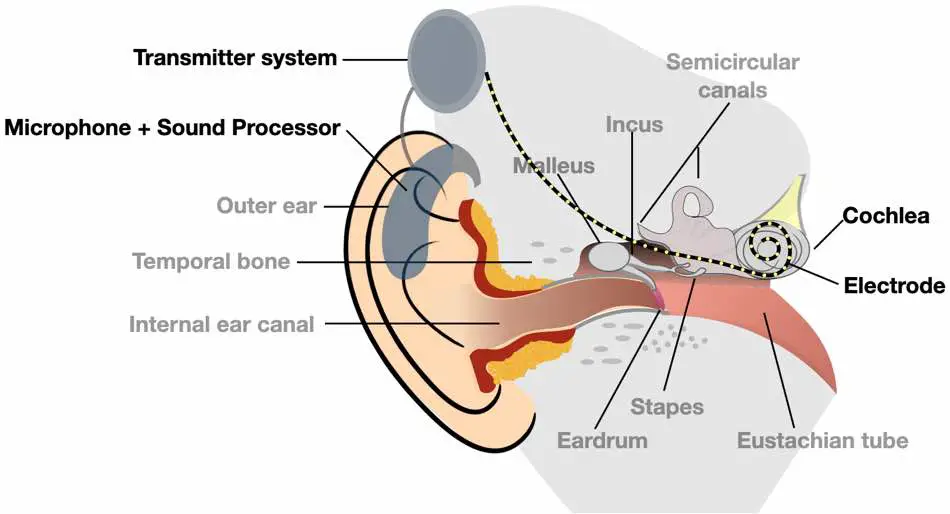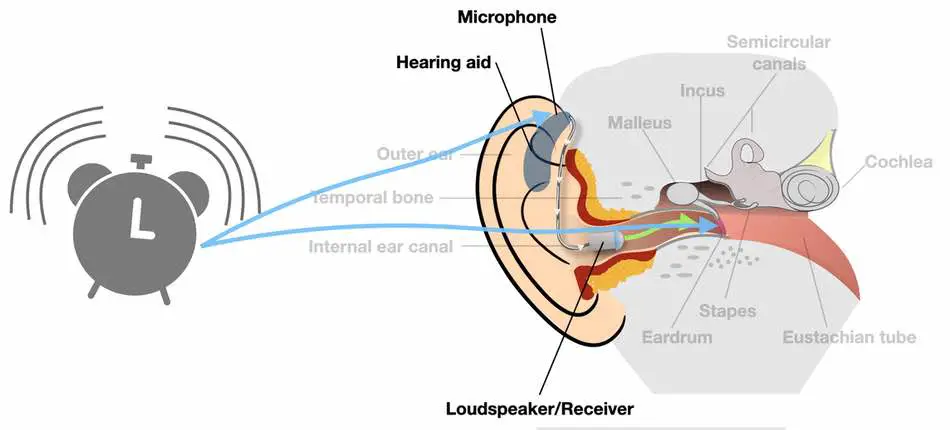Here in this article, you learn about the differences between hearing aids and cochlear implants. A hearing aid is a device that converts the environmental sound to an amplified version which will then send into the ear canal. The soundwaves then need to pass the eardrum, the auditory ossicles until the power of the sound wave reaches the cochlear. Here little hair cells need to be stimulated which are damaged or in some cases non-existent anymore.
But the little hair cells are needed to produce the signals to stimulate the auditory nerve. When they are severely damaged even maximal amplification levels will not lead to a better hearing experience. Because no signals get past the inner ear.
Cochlear implants do not rely on the inner ear to convert sound. Unlike hearing aids, they bypass the damaged hair cells and directly stimulate the auditory nerve electrically.
Cochlear implants and hearing aids work completely differently, but they can work together. When you wear a cochlear implant in one ear and a hearing aid in the other, it’s called bimodal hearing. But Now let us dive deeper into the differences between hearing aids and cochlear implants.
The Differences in the Way Hearing Aids and Cochlear Implant Are Built
The complete cochlear implant consists of an internal part, which consists of a coil, a signal processor with a stimulator, and an electrode lead. The electrode array is inserted into the cochlea during a surgical procedure. In contrast hearing aids basically consist of a microphone, an amplifier, and a loudspeaker.

The sound is picked up by the microphone, converted into electrical pulses, and processed in a microchip. This processes the incoming signal like a computer. The picture above shows a cochlear implant while in the picture below you can see a conventional hearing aid. As you can see the positioning of the parts which lead to a perception of sound are completely different.

While a hearing aid can always be put aside when the wearer does not want to wear it a cochlear implant has implanted components that always stay in the side of the head and the cochlear. One interesting difference between the two is also a cochlear implant actually does not make any noise. It only stimulates the acoustic nerve with electric impulses to produce the perception of sounds while a conventional hearing aid amplifies the sounds.
Can You Hear Normally With a Cochlear Implant?
Patients can hear not normally with cochlear implants. Because the contacts of the electrode deliver a more unsubtle perception compared to normal hearing. A modern electrode needs to reach the entire area of the cochlea – that is, from the entrance to the tip. Butt it has only a few contacts to produce the perception of sound.
Different areas of the cochlear lead to the perception of a certain frequency. When the electrode has more contacts in combination with optimal positioning the wearer of the implant can hear nearly normally.
Older cochlear implants had a problem with more distorted sound perception. The electrode with the old implants did not reach as deep into the cochlea. With less insertion of the electrode, patients heard only high-frequency sounds. This corresponded to distorted perception. Auditory impressions were more high-pitched than they actually are.
These days wearers of cochlear implants can hear the music too and have a much better understanding of speech when the acoustic nerve is fully intact. But the wearer might have to adapt to the new kind of hearing with the cochlear implant.
Do Cochlear Implants Give 100% Hearing?
100% hearing with cochlear implants is not possible. Cochlear implants do stimulate the auditory nerve only with up to 24 contacts of the electrode while the natural hearing cells provide thousands of diverse subtle ways to stimulate the acoustic nerve.
Even the most advanced technologies and signal processing strategies today in the field of CI systems are capable of transmitting only poor or even distorted representations of the sound. You do not need to necessarily hear 100% of the frequencies like a natural hearing person to understand 100% in a conversation.
But hearing in a more subtle way makes a lot of things easier. Like hearing where a sound came from. Or to hear what a person was saying in a very noisy environment.
Several studies up today have shown that different kinds of sounds require different amounts of information to be adequately perceived by a listener. With a cochlear implant, the information input is reduced compared to someone who hears naturally without a hearing loss. So depending on the individual case it might be still hard to hear certain things or understand speech.
You need to know the outcome or even if you are eligible for a cochlear implant is highly individual. When the vestibular nerve is damaged a cochlear implant will probably not benefit you. For most of the wearers, it is a life-changing device that enhances the ability to understand speech and recognize sounds a lot.
As conventional hearing aids evolved cochlear implants evolve too. These days they are available with a lot of accessories like apps that let you stream a podcast directly or listen to music. There are also external microphones available which make it easier to understand speech in noise.
They can be paired to your cochlear implant and of course with your hearing aids. Just ask your hearing care specialst. He or she will be happy to give you all the information you need.
